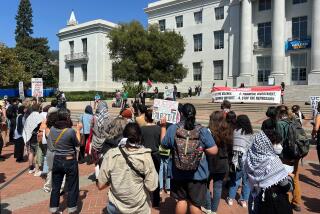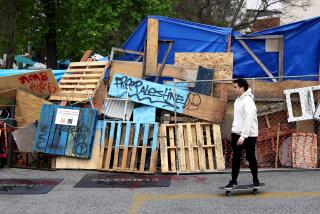Supply, but No Demand : After a Rush to Build Student Housing, CSUN Sees Its Occupancy Rate Plummet to 75%
For the last four years, Cal State Northridge officials have been rushing to build new campus housing facilities to meet a growing demand. But now, with the number of available spaces increased fivefold, many of the beds remain empty.
After years of occupancy rates topping 90%, the rate dropped this fall to about 75%. The occupancy rate would fall even further--to 66%--if all of the university’s 2,941 housing slots are considered, but about 340 of those are in a building to be closed for renovation.
CSUN officials blame the low occupancy rate on two unforeseen factors: a smaller freshman class caused by budget cuts, which reduced the number of classes at the university, and a down economy that is forcing many students to live with their parents to save money.
“If we had the ability of hindsight, to play Monday morning quarterback, it might have been wise to delay this last phase of housing for one more year,” said Edmund T. Peckham, vice president of student affairs and dean of students.
Still, Peckham remains confident that the nearly 3,000 dorm spaces is the right number for the 30,000-student campus.
“We’re going through some growing pains right now, but those pains will eventually be alleviated,” Peckham said. “In the long run, housing will prove to be a successful venture on this campus. In two or three years, we should be back at 90-plus occupancy rates.”
CSUN will need to get back to occupancy rates of more than 90% simply to break even financially, officials said.
But CSUN’s housing program will be able to survive financially for a few years with the lower occupancy rates because of the way housing is built and maintained throughout the 20-campus Cal State University system.
Money for housing comes from a statewide budget separate from each university’s general fund, according to Brad Wells, administrative program specialist for auxiliary business services for the Cal State system.
Wells said universities design their housing programs to be completely self-supporting, and each campus contributes to a contingency fund within the statewide housing budget. Wells said each campus develops its budget assuming expenditures on only 75% of expected revenues.
With that extra 25% margin--and the contingency fund as an additional backup--all Cal State universities can survive years when enrollments and revenues fall below expectations, Wells said.
None of the housing programs maintained by the system’s large campuses have experienced major money problems, but a sustained drop in demand for student housing at Cal State Bakersfield in the mid-1980s forced the conversion into staff offices of about 100 of 350 dorm spaces.
Rent collected from the offices goes into the housing fund.
Although statistics are not yet available this fall because of different starting dates, Wells said other campuses, including those in Long Beach, San Diego, San Francisco and San Jose, are expecting lower occupancy rates because of shrinking enrollments.
But CSUN is expected to take the biggest hit, partly because it operates the largest number of dormitories of any school in the Cal State system. Many of those dormitories are brand-new, adding pressure to pay off the construction debt.
The move to build more dorms began in 1987 when demand exceeded the nearly 670 spaces available in the University Tower Apartments, built in 1969, and the University Village Apartments, built in the early 1980s.
The newest housing complex, the University Park Apartments, was built in three phases for more than $30 million and contains about 2,300 dorm spaces.
With completion of the new dorms, CSUN officials plan to close the Tower this fall to undertake more than $2 million in renovations there, including plumbing, electrical and roofing repairs as well as seismic and asbestos studies.
The CSUN housing program came under scrutiny last year when auditors discovered that through poor management, hundreds of students had skipped out on about $2.8 million in unpaid rents since 1988. Much of the back rent has since been collected by university officials, mostly by refusing to let scofflaws register for classes or limiting their access to student records. The university also employed a collection agency to recoup the debts.
Aside from the crackdown on delinquent students, housing officials said they have seen a trend developing away from students living on the Northridge campus.
Cindy Derrico, assistant director of residential life, said many students prefer to live away from campus for independence from dorm rules and regulations. Living in the dorms--which does not include meals--costs about $1,800 a year per student in a double room, which is comparable to prevailing rates at surrounding private apartments.
Freshman Robert Day, 18, and his buddies, juniors John Reddel, 21, and Greg Field, 21, are living in the dorms this year simply to become more familiar with the area and to meet more people so that they can get an apartment off campus next year.
“It’s a little more freedom,” Day said of the prospect of living off campus. “And it won’t be a dorm.”
The pool of potential tenants for dorms has also shrunk from previous years because of the lingering recession and the smaller freshman class.
“A lot of students have been forced to live at home because the family is just unable to make the financial adjustment,” said Peckham, noting that the majority of students come from neighborhoods within an hour’s drive of campus.
“The issue of the economy, and with the increased costs for students to even go to college, students are just forgoing some luxuries, and for many of them, living on campus is a luxury,” Derrico said.
If some students cannot afford to pay for on-campus housing, and the university is concerned about low occupancy rates, then why not simply lower the rents so that some revenues, small as they may be, will still come in?
CSUN Vice President Elliot Mininberg said it’s not that simple.
“We already have adjusted to a point that is reasonable to be market-competitive,” said Mininberg, in charge of administration and university advancement. “It’s not like selling cars, where you lower costs to get rid of inventory because new cars are coming in. If you undersell housing, you undermine your ability to sell fairly when market conditions return.”
University officials said freshman enrollment is down because of increased costs in fees and fewer classes being offered as a result of state budget cuts. Freshmen traditionally make up 55% to 65% of students who live on campus.
But if attracting students to live on campus has been difficult this year, it has always been difficult to persuade students to return to campus housing. Derrico said only 15% to 20% of residents return to the dorm for a second year.
“For upperclassmen, they see it as developmental to move on to an apartment off campus,” she said.
CSUN makes up for a shortage of students during the summer by renting out the dorms to outside groups who have programs on campus. Those services may be extended during the academic year to keep rooms full, Derrico said.
But she is hoping that new programs and aggressive marketing can get students back into the dorms.
This year, for the first time, the university is trying to group students with similar interests in the same dorm. Derrico said early response has been good for a “quiet/study” dorm as well as “health and fitness” and “multicultural” dorms. There has been less success organizing separate floors for academic groups, such as business and fine arts.
“We are trying to do everything we can programmatically to attract students,” she said. “We are searching for students who want that full college experience.”
It was that full college experience that led freshman Chris Reed to live in the dorms, even though he lives just a few miles away in North Hollywood.
“Part of the college experience is living in the dorms,” said Reed, 18. “If you just drive here, socially, you haven’t had the full experience.”
Sophomore Eric Sheldon, 19, of La Mirada said living in the dorms instead of a private apartment was a financial decision. “It’s easier when you pay a flat rate and don’t have to worry about paying for utilities,” he said.
But for Becky Meeker and her friends, Linda Stewart and Stacy Wong, all 21-year-old juniors living with their parents in West Los Angeles, living in the dorms was never even a consideration.
“I’ve never even met anybody who has lived in the dorms,” Meeker said.
Occupancy at CSUN Dorms
1989 1990 1991 Number of spaces available 1,442 2,003 2,941* Average occupancy rate 97% 90% 66%*
Source: Auxiliary and Business Services Office, California State University
* CSUN Housing Department estimates (complete 1991 figures not available)
More to Read
Sign up for Essential California
The most important California stories and recommendations in your inbox every morning.
You may occasionally receive promotional content from the Los Angeles Times.










